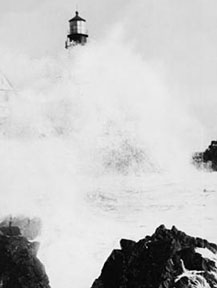One such instance followed The Great New England Hurricane of September 21, 1938, a few days after which "a specimen of Phaethon lepturus catesbyi was found at East Winn, Penobscot County, Maine, about seventy miles inland."
 This bird is in fact a subspecies that is held up as one of the main wildlife characters of Bermuda, and has featured on their stamps repeatedly, the most recent being the August 2005 release of stamps depicting the island's most unique habitats. (see image, upper righthand stamp)
This bird is in fact a subspecies that is held up as one of the main wildlife characters of Bermuda, and has featured on their stamps repeatedly, the most recent being the August 2005 release of stamps depicting the island's most unique habitats. (see image, upper righthand stamp)To quote the Crown Agents Stamp Bureau:
Bermuda’s Rocky Shores would not be the same without the White-tailed Tropicbird (Phaethon lepturus catesbyi). Locally called Longtail, this ‘harbinger of spring’ arrives in March to perform spectacular aerobatic courtship displays, and eventually to rear a single chick in cliff crevices, high above the tides. Both parents and offspring leave by October to spend the winter on the open Sargasso Sea where they feed mostly on squid.Mmm... squid.
The event was documented in the April 1943 issue of the Auk, a natural history magazine of the day, by Arthur H. Norton, of the long defunct Portland Society of Natural History. Mr. Norton objectively explains his theories on how the bird was "driven before the gale to its doom," and remarks, "This appears to be the first instance in which this bird has been noted in Maine."
 For your further enjoyment, I present a photo of Portland Head Light during the 1938 storm backwash from the historic hurricane (known in some quarters rather flippantly as the Long Island Express).
For your further enjoyment, I present a photo of Portland Head Light during the 1938 storm backwash from the historic hurricane (known in some quarters rather flippantly as the Long Island Express).While I found no record of any damage done to the Head Light during that particular storm, note is made on the Portland Head Light history page of impressive marks left by later hurricanes:
In February 1972 Coast Guardsman Robert Allen reported to the Maine Sunday Telegram that a storm had torn the 2,000 pound fog bell from its house, ripped 80 feet of steel fence out of concrete and left the house a "foot deep in mud and flotsam, including starfish." A wave had broken a window in the house 25 feet high.
Another good Portland Head Light site I found is about the history of the Strout family as paired with the Head Light for over a century, in an account by John Strout on the Lighthouse Digest site. It is a tale of shipwrecks, watchfulness, foghorns, a flower garden, and lots of painting over the years.
No comments:
Post a Comment